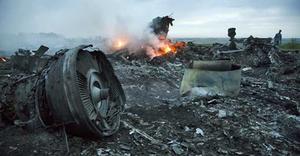Aviation securityRenewed interest in defending civilian airlines raised by MH17 downing, Israel flight ban
The 48-hour ban on international flights to and from Ben Gurion International Airport in Israel was the result of a Hamas rocket landing in Yahud, a small town about a mile-and-a-half from the airport. The likelihood of a rocket fired from Gaza landing on the runways or terminal at Ben Gurion airport is small not only because of the inaccuracy of these rockets, but also because of the effectiveness of Iron Dome, Israel’s anti-rocket defense system. A much greater threat to civilian aviation is posed by surface-to-air missiles – either shoulder-mounted anti-aircraft missiles (or MANPADS, for man-portable air defense systems) or the much more powerful truck-mounted systems such as the SA-11, or BUK system, which Ukrainian separatists used to bring down flight MH17.

Wreckage of Malaysia Airlines MH17 // Source: baoveviet.com.vn
The 48-hour ban on international flights to and from Ben Gurion International Airport in Israel was the result of a Hamas rocket landing in Yahud, a small town about a mile-and-a-half from the airport. The likelihood of a rocket fired from Gaza landing on the runways or terminal at Ben Gurion airport is small not only because of the inaccuracy of these rockets, but also because of the effectiveness of Iron Dome, Israel’s anti-rocket defense system.
A much greater threat to civilian aviation is posed by surface-to-air missiles – either shoulder-mounted anti-aircraft missiles (or MANPADS, for man-portable air defense systems) or the much more powerful truck-mounted systems such as the SA-11, or BUK system, which Ukrainian separatists used to bring down flight MH17.
There are about 10,500 large passenger planes operating around the world (about 7,000 of them in the United States). There are more than 500,000 MANPADS around the world, many tens of thousands of them available on the black market. The U.S. intelligence community says that 32 of the 50 groups designated by the United States as Foreign Terrorist Organizations have such missiles in their possession.
The MANPADS were designed to bring down a military fighter plane. Shooting down a passenger plane is much easier. Governments and security authorities around the world have been considering how best to defend civilian aviation from the threat of MANPADS, but with one exceptions – Israel – all other countries have decided that the MANPADS threat to civilian aviation was too low relative to the cost of defending against them.
Several defense contractors have developed counter-MANPAD technologies. Northrop Grumman and BAE have received $45 million from DHS to adapt the laser-based defenses system currently used on military aircraft for civilian use. Raytheon has another solution: since planes are most vulnerable to shoulder-fired missiles when the planes are closer to the ground, that is, during take-off and landing, the company has developed its Vigilant Eagle ground-based system, which protects the airspace above and around airports instead of protecting individual aircraft. Swedish company Saab has developed a system which squirts a chemical in the path of the climbing missile to divert it.
The technologies to protect airplanes from MANPADS exist, but the issue of cost has not been resolved. DHS has set a target cost of $1 million for protecting one airplane, including not only the initial equipment and its installation, but maintenance as well. Studies have estimated that equipping the entire U.S. commercial fleet with such devices could cost as much as $7 billion and take twenty years to complete.
Perry Flint of IATA, representing the airline industry’s view, says that the cost of equipping the entire U.S. civilian fleet with anti-MANPADS system, and then maintaining these systems over twenty years, would be $43 billion.
Israel was given a demonstration of the MANPADS threat in 2002, when two SA-7 missiles were fired at an El Al jetliner as it took off from the airport in Mombasa, Kenya. In response, the Israeli technology company Elbit began working on its Sky Shield system (the official name of the system is SkyShield/ Commercial Multi-Spectral Infrared Countermeasures [C-MUSIC]), and the Israeli government allocated $76 million for equipping Israeli jetliners with the system.
The first flight of an Israeli civilian jetliner equipped with the Sky Shield system took place in May 2013, and it was followed by four months of intensive testing. The system has since been installed on all of El Al planes.
The Israeli government helped pay for developing and installing the system, but El Al and the government have not yet agreed on the government’s role in paying for the maintenance of the system.
Sky Shield uses Directional Infrared Counter Measures (DIRCM) to force the missile away from a collision course with the airplane, and the missile’s built-in self-destruct system then destroys the missile without doing damage to the plane.
The system uses four sensors to monitor an “envelope” of a few miles around the plane. The sensors identify the missile by the heat it generates. When the missile gets closer to the plane, an intense laser beam is aimed at the heat-seeking mechanism of the missile, “blinding” it and causing it to lose its ability to locate the plane.
The system operates automatically, without the pilots’ intervention.
Elbit says that the system is easy to install – it takes about one hour to install it on a plane – and that it can be uninstalled and moved to another plane of necessary. This means that an airline would not have to equip all its planes with the system. Rather, the planes will just have to be made system-ready, and the system will be installed only on those planes flying to regions believed to be risky.
